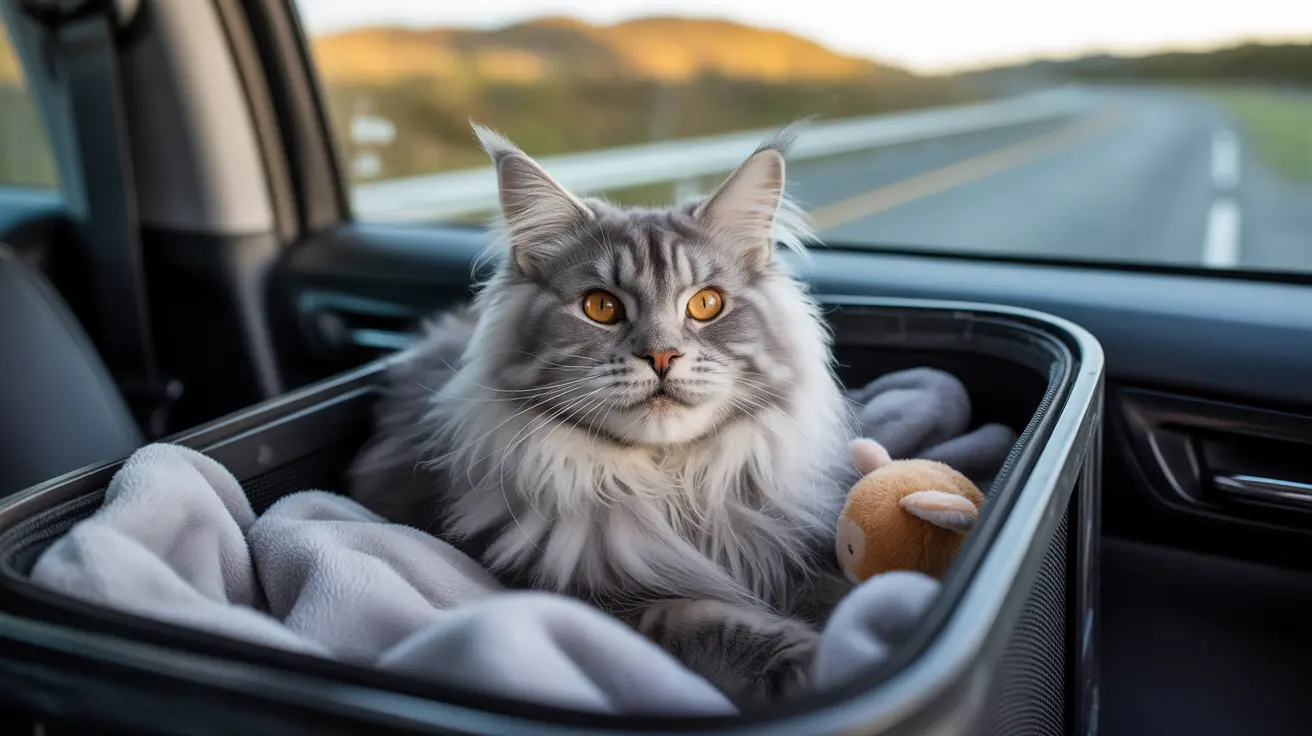Essential Traveling with Your Cat Tips: A Complete Guide for Stress-Free Adventures
Traveling with your beloved feline companion doesn't have to be a stressful ordeal for either of you. While cats naturally prefer the comfort and familiarity of their home environment, with proper preparation and the right approach, you can ensure your furry friend enjoys the journey as much as the destination. Whether you're planning a cross-country road trip, a flight to visit family, or an international adventure, understanding how to travel safely and comfortably with your cat is essential for any responsible pet owner.
The key to successful cat travel lies in thorough preparation, patience, and respect for your cat's individual personality and needs. Some cats adapt remarkably well to travel and may even enjoy new adventures, while others require more time and careful conditioning to feel comfortable away from home. This comprehensive guide will provide you with expert-approved traveling with your cat tips to ensure both you and your feline friend can explore the world together safely and stress-free.
Preparing Your Cat for Travel: The Foundation of Success
Successful cat travel begins weeks or even months before your departure date. The most crucial aspect of preparation involves gradually acclimating your cat to their travel carrier and the concept of being transported. Start by introducing the carrier as a positive space in your home, placing it in a comfortable area with familiar blankets, treats, and toys inside. Allow your cat to explore and rest in the carrier voluntarily, creating positive associations with what will become their travel sanctuary.
Once your cat shows comfort with the carrier, begin taking short practice trips around the block or to nearby locations. These brief excursions help reduce anxiety and prepare your cat for longer journeys by building their confidence and trust in the travel process. During these practice sessions, observe your cat's behavior and stress levels to identify any areas that may need additional attention or veterinary consultation.
Choosing the Right Carrier and Travel Equipment
Selecting an appropriate carrier is fundamental to your cat's travel comfort and safety. The ideal carrier should feature both front and top openings, allowing comfortable entry and exit options for your cat. Ensure the carrier is spacious enough for your cat to stand, turn around, and lie down comfortably. For larger cats, invest in carriers specifically designed for bigger pets to prevent cramping and discomfort during extended travel periods.
For car travel, choose a sturdy carrier that can be secured level with a seat belt, providing stability throughout the journey. Consider carriers with waterproof bottoms for airplane travel, as these meet most airline requirements and provide practical protection against accidents. Some cats benefit from having a blanket draped over their carrier to reduce visual stimuli and create a more den-like environment that promotes relaxation.
Essential travel equipment should include harnesses and leashes for safety during stops, cleaning supplies such as paper towels and unscented wipes, extra blankets or towels for accidents, and absorbent pads for the carrier base. Always ensure your cat has proper identification, including a microchip and collar with current ID tags, in case of unexpected separation.
Travel Safety Guidelines by Transportation Mode
Car Travel Essentials
When traveling by car, securing your cat's carrier properly is crucial for both safety and comfort. Position the carrier level and secure it with seat belts to prevent sliding or tipping during turns and stops. Never allow your cat to roam freely in the vehicle, as this can cause dangerous distractions and potential injury in case of sudden stops or accidents.
For longer car trips, plan regular stops to allow your cat breaks for drinking water, using their portable litter box, and stretching. Always keep cats restrained in carriers or harnesses while the vehicle is moving. Bring your cat's usual litter box and preferred litter for extended trips to minimize stress associated with unfamiliar scents and textures.
Air Travel Considerations
Airplane travel requires additional preparation and documentation. Confirm airline policies regarding carrier size, pet requirements, and any breed restrictions well in advance of your departure. Cats with brachycephalic (flat-faced) breeds are often not permitted to fly due to increased respiratory risks at altitude.
Plan direct flights whenever possible to minimize stress and reduce the risk of complications during layovers. Prepare all necessary documentation, including health certificates, vaccination records, and any required international travel papers, well ahead of your travel date. Some airlines have limited pet spaces available, so book early to secure your cat's spot.
Train Travel Requirements
When traveling by train, research specific carrier size and weight restrictions, as these can vary significantly between rail services. Pet spaces on trains are often limited, making advance booking essential. Ensure your carrier meets the specific dimensions required and that you have all necessary documentation for your journey.
Managing Cat Stress and Anxiety During Travel
Travel-related stress is common in cats and can manifest through various behavioral changes and physical symptoms. To minimize anxiety, maintain familiar routines as much as possible and bring along your cat's favorite toys, blankets, and food to create a sense of security during the journey.
Calming pheromone sprays or wipes can help reduce anxiety when applied to the carrier before travel. Products like Feliway Spray have proven effective for many cats. However, any anxiety medications or supplements such as Solliquin, Composure, or gabapentin should only be used after consultation with your veterinarian, who can assess your cat's individual health and temperament needs.
Avoid sedation unless specifically recommended by your veterinarian, and always test any prescribed medications at home before travel to observe your cat's reaction. Special diet foods containing natural stress regulators are available through veterinarians and can help reduce stress-related symptoms, but these require early introduction before the trip to be effective.
Creating a Stress-Free Environment
Your own demeanor significantly impacts your cat's stress levels, as cats often mirror their owner's anxiety. Maintain a calm, positive attitude throughout the travel process, speaking to your cat in soothing tones and providing gentle reassurance. Keep the travel environment as quiet and stable as possible, avoiding sudden movements or loud noises that might startle your feline companion.
During the journey, offer water periodically on trips longer than five hours, but avoid feeding your cat 4-5 hours before departure to prevent motion sickness and accidents. Small amounts of water can be provided during longer trips, but monitor your cat's intake to prevent overhydration and frequent urination needs.
International Travel Requirements
International travel with cats requires extensive preparation and documentation. Research destination requirements for vaccinations, health certifications, and potential quarantine periods well in advance. Some countries have specific breed restrictions or lengthy quarantine requirements that could significantly impact your travel plans.
Ensure all vaccinations are up to date and obtain the necessary health certificates from your veterinarian. Some international destinations require specific blood tests or treatments completed weeks or months before travel, making early planning essential for successful international cat travel.
Helping Your Cat Adjust to New Environments
Once you reach your destination, allow your cat time to acclimate to their new surroundings gradually. Cats may behave unusually or show signs of stress in unfamiliar environments, which is completely normal. Respond with patience, extra attention, and affection during this adjustment period.
Set up a quiet, secure space for your cat with familiar items like their bed, toys, and litter box. Allow them to explore the new environment at their own pace, providing safe spaces where they can retreat when feeling overwhelmed. Some cats adapt quickly to new locations, while others may need several days to feel comfortable.
Emergency Preparedness While Traveling
Prepare for potential emergencies by researching veterinary clinics near your destination before departure. Keep your veterinarian's contact information readily available, along with your cat's medical records and any prescription medications. Pack a basic first aid kit with items recommended by your veterinarian for common travel-related issues.
Ensure your cat's identification is current and clearly visible, including both collar tags and microchip registration. Consider bringing recent photos of your cat in case of separation, and keep important phone numbers easily accessible throughout your journey.
Frequently Asked Questions
- How long before travel should I stop feeding my cat?
You should stop feeding your cat 4-5 hours before departure to prevent motion sickness and reduce the likelihood of accidents during travel. However, small amounts of water can be offered periodically on trips longer than five hours.
- Can I give my cat medication to help with travel anxiety?
Only use anxiety medications or supplements after consulting with your veterinarian, who can assess your cat's individual health and temperament. Options like Solliquin, Composure, Feliway Spray, or gabapentin may be recommended, but always test any prescribed medication at home before travel.
- What size carrier do I need for airplane travel?
Carrier size requirements vary by airline, so confirm specific policies well in advance. Generally, soft carriers with waterproof bottoms are preferred for air travel. The carrier must be large enough for your cat to stand, turn around, and lie down comfortably while fitting under the airplane seat.
- How can I help my anxious cat adjust to a new destination?
Create a quiet, secure space with familiar items like their bed, toys, and litter box. Allow your cat to explore at their own pace and respond with patience, extra attention, and affection. Some cats may show unusual behavior initially, which is normal and typically improves with time.
- Should I let my cat out of the carrier during car travel?
Never allow your cat to roam freely in the vehicle while driving, as this creates dangerous distractions and injury risks. During stops, use a harness and leash if removing your cat from the carrier, and always keep them secured while the vehicle is in motion.
- What documentation do I need for international travel with my cat?
International travel typically requires health certificates, current vaccination records, and sometimes specific blood tests or treatments. Requirements vary significantly by destination, so research well in advance and consult with your veterinarian about necessary preparations weeks or months before travel.
- How do I know if my cat is too stressed to travel?
Signs of excessive stress include prolonged hiding, loss of appetite, excessive vocalization, or aggressive behavior. If your cat shows severe stress symptoms during practice trips or preparation, consult your veterinarian for guidance on stress management techniques or whether travel is appropriate for your individual cat.
Conclusion
Traveling with your cat can be a rewarding experience when approached with thoughtful preparation, patience, and respect for your feline friend's individual needs. The key to success lies in gradual acclimation, proper equipment selection, and maintaining a calm, supportive environment throughout the journey. Remember that some cats naturally adapt well to travel and adventures, while others may prefer the comfort of home – both responses are perfectly normal.
By following these comprehensive traveling with your cat tips and working closely with your veterinarian, you can ensure safe, comfortable adventures together. With proper preparation, appropriate gear, and careful attention to your cat's comfort and safety, exploring new destinations with your beloved companion can create wonderful memories while strengthening the bond between you and your feline friend.






